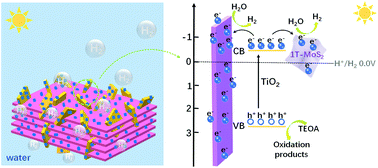1T-MoS2 nanopatch/Ti3C2 MXene/TiO2 nanosheet hybrids for efficient photocatalytic hydrogen evolution†
Abstract
The biggest challenging issue in photocatalytic hydrogen production is to efficiently separate the photoinduced electron–hole pairs, which requires the enrichment of photoinduced electrons on the photocatalyst's surface. Herein, TiO2 nanosheets (NSs) are in situ grown on highly conductive Ti3C2 MXene and then 1T-MoS2 nanopatches are uniformly distributed on the Ti3C2/TiO2 composite through a two-step hydrothermal method. Thus, a unique 2D structure of the Ti3C2/TiO2/1T-MoS2 composite with double metallic co-catalysts Ti3C2 and 1T phase MoS2 nanopatches is achieved, and the content of 1T phase reaches 84%. The photocatalytic H2 production rate of the Ti3C2/TiO2/1T-MoS2 composite with an optimized MoS2 loading amount (15 wt%) is nearly 132, 11, and 1.5 times higher than that of pure TiO2 NSs, Ti3C2/TiO2 composites and Ti3C2/TiO2/2H-MoS2 composites (15 wt%). The 1T-MoS2 nanopatches on the surface of the Ti3C2/TiO2 composites increase the specific surface area and boost the density of active sites. Besides, the presence of Ti3C2 MXene and 1T phase MoS2 is found to enhance the electronic conductivity, resulting in an increase in efficiency for electron transfer.

- This article is part of the themed collection: 2019 Materials Chemistry Frontiers HOT articles


 Please wait while we load your content...
Please wait while we load your content...